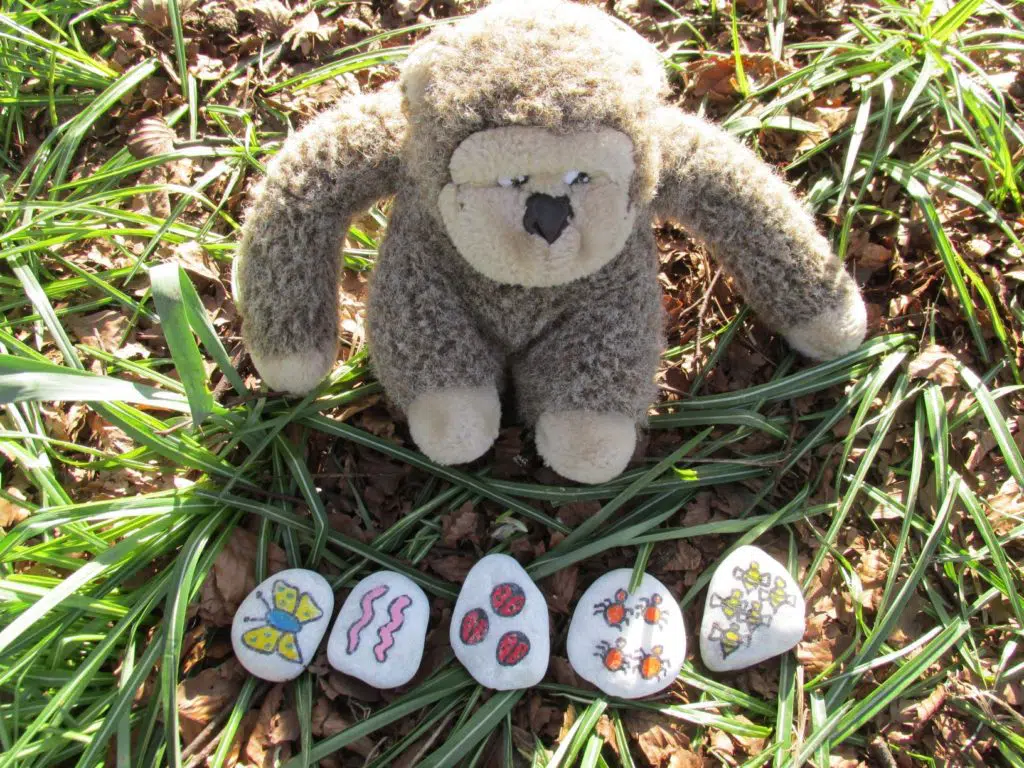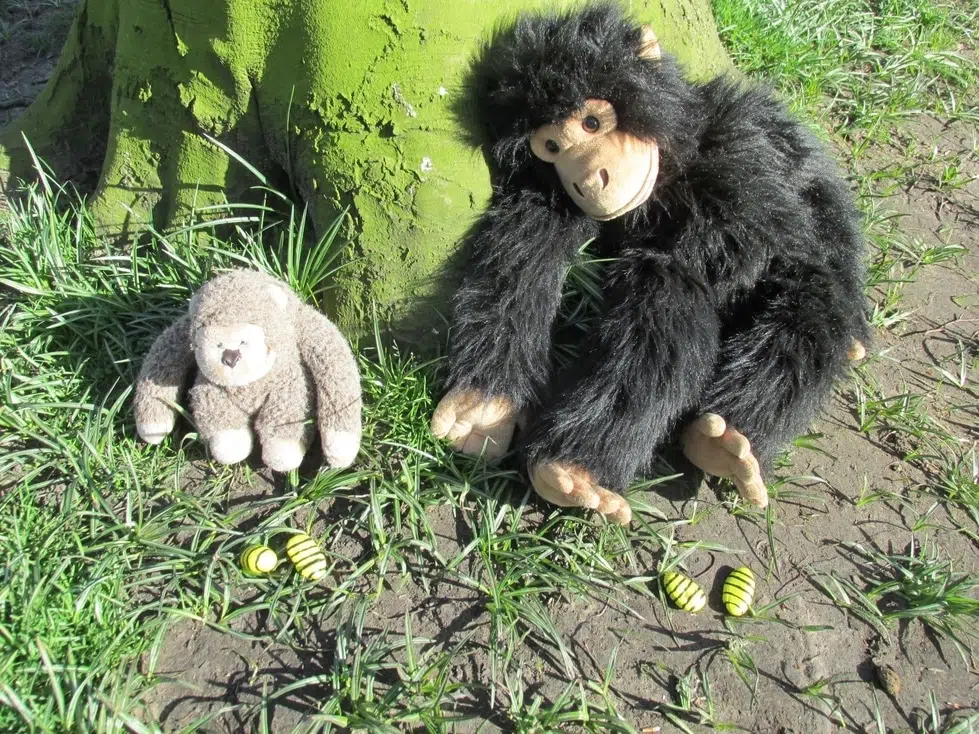Many of us will have experienced that sense of awe that a puppet can generate. Children are not always massively bothered about listening to what the grown up is about to say, but a puppet – well, that’s quite a different story!
I really do find it like magic. They sit and stare when the puppet comes out, and so use this magic to its full advantage!
There are many things that you can teach with puppets – phonics, listening, social skills, and especially maths. But how can you do it?
Puppets can be used to teach a range of maths skills. Finger puppets really help with teaching counting songs. Larger puppets can be used to teach counting, missing numbers and other skills like starting counting at a given number. Puppets can also be utilised very effectively to teach more advanced skills like problem solving, sharing, and simple addition and subtraction.
Read on to find out my favourite fourteen maths activities that use puppets:

1. Use finger puppets with a song
This takes a bit of preparation either to make the finger puppets or buy them.
Lots of counting songs have five as their opening number. This is because we have five fingers on one hand, and so it is easy for children to manipulate this number on their fingers.
Good songs to try the finger puppets strategy are classics like Five Little Men in a Flying Saucer, or Little Speckled Frogs. Simply put the five frog puppets on your fingers, for example, sing the song, and then take one off.
Do lots of counting through the song – repeat, repeat, repeat. Also throw in lots of vocabulary like ‘now we’ve got one less’, ‘the number’s getting smaller’, ‘we’ve got fewer’, and all that kind of thing.
2. Use a puppet to count
Some kind of bigger puppet is required for this. You could even use a teddy or a similar toy.
The puppet is going to count in different ways. The children join in. Start off just counting from 1 nice and slowly.
This is one of my favorite rote counting games (check out the top 17 here).
3. A puppet misses a number out
A great introduction to missing numbers. The puppet counts but leaves one number out. For example, it says ‘1,2,3,4…6,7,8.’ I try to leave a nice big silent pause in the place where the number should be. What has he missed out?
4. He can go wrong!
Children love it when things go wrong! There is no greater joy than when a teacher makes a mistake, and the same can be applied to puppets.
Openly making mistakes and being honest about them is also a great thing for children to become aware of. Many children, like adults, fear making mistakes, and this can really hold them back.
To do this activity, the puppet simply counts, but something will go spectacularly wrong. For example, it might go ‘1,2,3,4,7.’
‘What went wrong? What number should have come after 4?’ If you can get the children to explain to the puppet where it is going wrong, it is beginning the process of reasoning, and explaining your mathematical thinking.
This game is an excellent introduction to missing numbers. It is also a fun way of consolidating rote couning (counting in sequence). If you want to find out more about what rote counting is (and how to teach it), then take a look at this.
5. Start counting on from a number given by the puppet
This is the next step, after the children have become reasonably secure in counting I would say at least well into the teens. It is then a good idea for them start at different numbers. The reasons for this are to add flexibility to their thinking, and also to begin to help them calculate and count on to add.
Have a box or bag of numbers. The puppet takes out a number, e.g. 6. We all try to count on from 6 together – 6,7,8,9,10,11. I always try to go past 10 as this is a useful skill in itself.
6. Word problems
Story telling with puppets is a great way to introduce word number problems. (Check out the ultimate storytelling with puppets games to try out here).
It particularly works well if the puppet is upset or angry! The children really want to get to the bottom of the puppet’s issues.
The puppet will whisper what’s happened in the adult’s ear. You say things like ‘Max is really upset. He had five sweets but then Dave the Dog robbed two! How many has he got left?
7. Sharing into two groups
This is my favourite way of introducing the concept of mathematical sharing for the first time. This is one of the articles I included in my best 22 teaching activities using puppets.
I find that sharing is usually quite easy for children to understand in this context, as it is something they will have experienced numerous times before in the courses of their everyday lives.
Have two puppets (or toys works well also). Have a bit of a story worked out and a few props. It could be that they are going to share some apples.
Say something like ‘Bill and Bella have 6 apples but they don’t know how many they should have each. They want to make it fair. How can we work it out?’
Demonstrate how to give one apple to one toy, then one to the other. Continue. Children usually get this idea of fairness.
Then repeat the scenario with a different number of apples, and get the children to have a go at sharing.
This is a skill they can try by themselves in different learning areas, if they have a few puppets or toys that they have access to.

8. Find one less
Puppets can really bring counting songs to life. For example, you could have 5 toy ducks for the song ‘Five Little Ducks Went Swimming One Day’.
Everyone sings the song, and then get the puppet to take one duck away. How many are left?
The children could help the puppet take the duck away. This is a real treat, and good for behaviour as of course only those sitting amazingly can be chosen.
9. Using a finger puppet to point to a counting stick
This is probably my favourite counting stick activity.
Counting sticks are a fantastic introduction to number lines, and children can learn a range of skills from them. One of the best activities is to stick numbers onto the number line, and put a finger puppet on your index finger.
Say to the children, ‘Follow the puppet. Say the number that he lands on.’
There are many different ways you can count, including:
- Count forwards
- Jump on random numbers
- Count backwards (Check out the best 18 counting backwards games here)
- Take the numbers off and try all the same games again. This is much harder.
10. Using finger puppet to skywrite numbers in air
Give all the children a finger puppet if you have them. They could potentially make their own.
Put on some pumping music! Anything with a good loud beat will work.
Try writing the numbers using big movements in the air. Remember to bend your knees and stretch up high. I always demonstrate the numbers at the front going backwards to me, so they will copy them from left to right (like a mirror). Repeat writing each number several times, and try to fit your movements to the music.
11. Counting Aerobics!
This is a bit like aerobics led by the puppet. Music is optional, but it can definitely spice things up.
Pick a move that the puppet will do, e.g. jiving with its arm.
Get the children to copy and all count at the same time.
Then pick different actions and count. Always go past ten. Bridging ten is an important skill for children to learn.
12. Counting backwards
This is good when combined with a number line. A large number line on the floor works well.
A child can hold the puppet, and jump backwards along the line, saying each number as they go.
The puppet could also be pointing to a number line on the wall. Say the number the puppet points to, and count backwards.
This is a brilliant outdoor maths game, and you can find 50 other outdoor maths ideas here.
13. Adding objects
A few random objects or toys added together can be really brought to life by a bit of a story linking them to puppet. For example, a few conkers become the puppet’s conkers that he found that morning in the park. He found some under one tree, and some under another. How many has he got altogether.
The maths skills involved are the same as if you did it without a puppet, but the puppet just adds to engagement, interest and behaviour.
14. Ordering through size
Put the puppets in order from biggest to smallest! A great one for teaching vocabulary of length, as well as the concepts involved in ordering.
To find out exactly what ordering is, and the best ways to teach it, then check this out.
Conclusion
Puppets are a quick and effective solution to teach basic maths concepts. You can tap into that magical awe that they hold for children to really get their attention.
Skills taught in more formal, adult-led contexts, can be transferred into play if children have access to puppets and toys in the learning environment. They are fantastic for teaching counting in a range of ways, number recognition, and simple calculating strategies.
If you’ve found this useful, then why not check out one of these articles:
